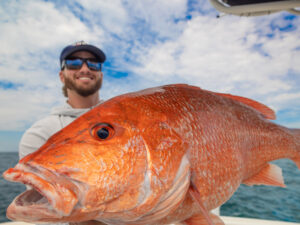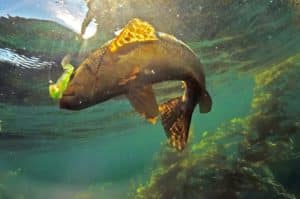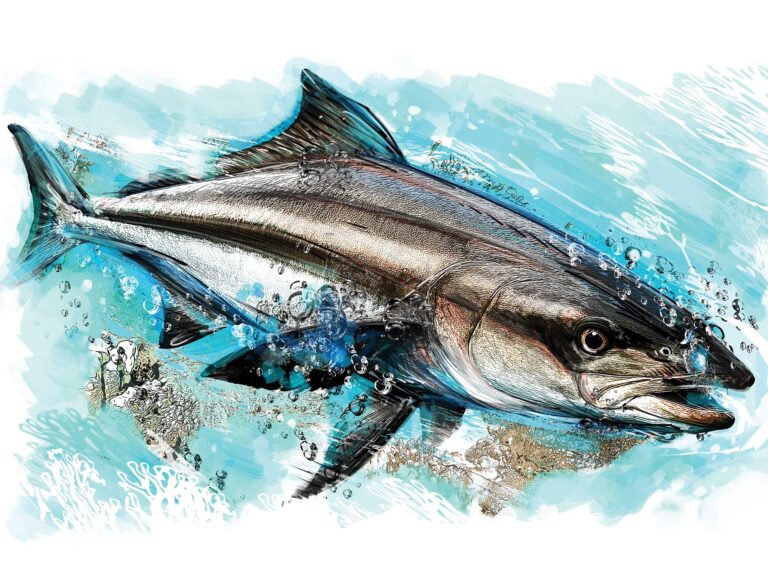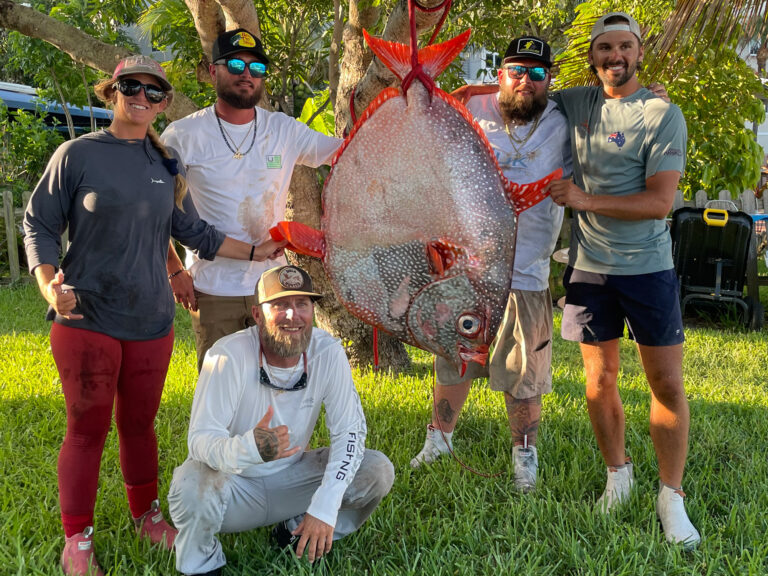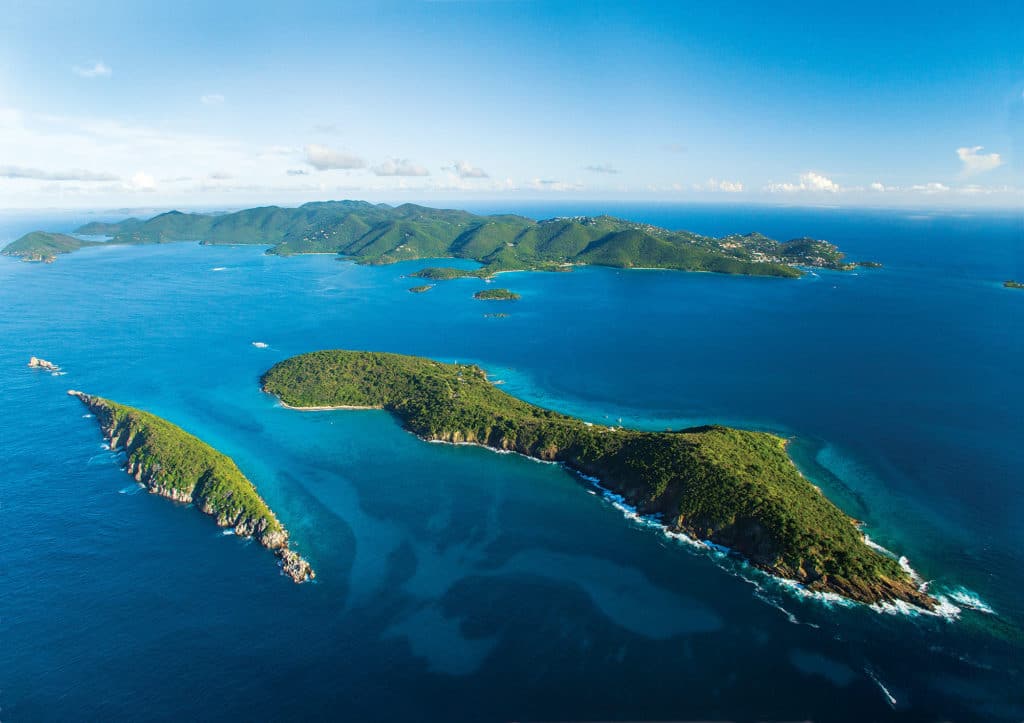
As our 35-foot center-console rode the big Caribbean swells, I couldn’t believe I had actually pulled off my escape from the snowiest winter ever recorded in New England. Just two days earlier, on February 15, I had been gazing at the barren, wind-blasted tundra purported to be Boston’s Logan Airport, where the temperature was so cold it had caused the tow bar of our plane’s pushback tractor to snap like a strand of uncooked spaghetti. As the crew waited for a replacement tractor to arrive, an entire jetload of dejected passengers was thinking the same thing: We shall never leave this cursed land!
Yet here I was, with friend Jonathan Craig, heading toward bluewater adventure off St. Thomas and St. John in the U.S. Virgin Islands. The six- to eight-foot seas heaving beneath the hull were a parting shot from the big storms that had pummeled my home coast nearly every week since mid-January, but we didn’t mind. For once, it wasn’t snowing.
“This has been a particularly rough winter for us too,” acknowledged Capt. Jonathan Gatcliffe, who, along with mates Tyler Maltby and Glenn Charlett of Double Header Sportfishing, had picked us up in St. John’s Cruz Bay. Like ripples expanding in a pond, swells generated by winter nor’easters in New England often extend to the Caribbean, creating heavy surf along the islands’ north-facing shores and stirring up the inshore waters. Fortunately for Virgin Islands fishermen and visiting anglers, there are plenty of options, especially if you have a big center-console at your disposal.
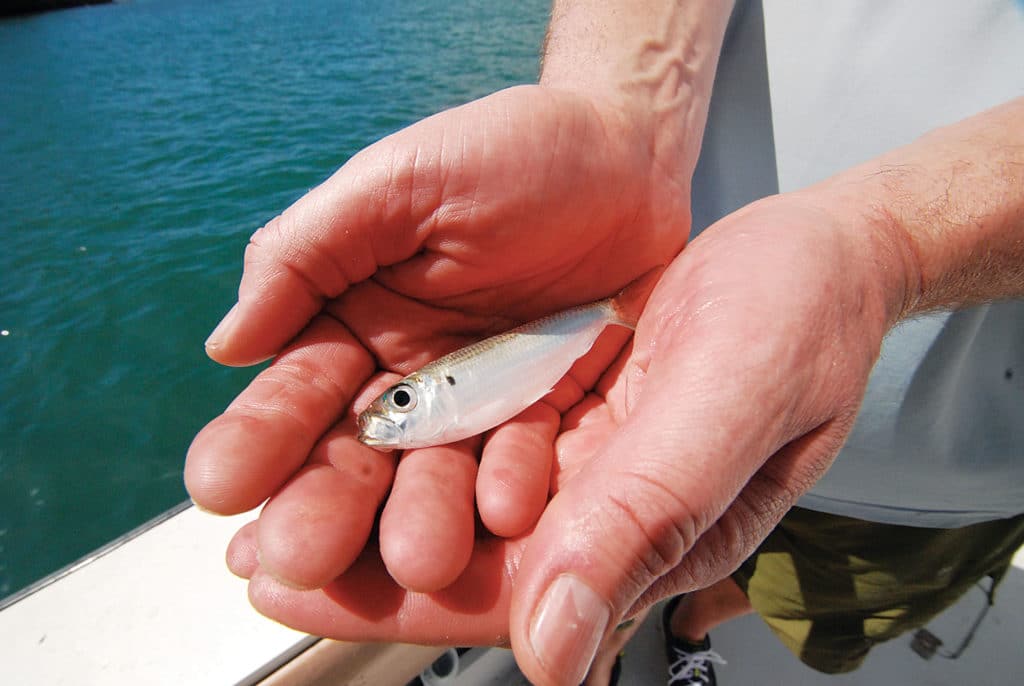
Pilchard Power
Despite the heavy seas, our destination was the legendary North Drop, offshore grounds made famous by big-game pioneer Johnny Harms in the 1960s. Fishing out of St. Thomas, Harms discovered that this abrupt curve in the continental shelf 20 miles north of the island, where the depth plunges from 200 to more than 2,000 feet in less than a quarter-mile, produced immense upwellings that attracted baitfish and large predators. Happily, it still does.
Unlike the traditional method of trolling for offshore species, the Double Header crew prefers live-chumming, a technique Gatcliffe imported from his home island of Trinidad. Gathering the 500 pilchards needed before each trip is a lot more work than dragging lures, but it usually pays quick dividends, as we discovered immediately upon pulling up to a lobster-pot buoy that had been set near the edge of the shelf drop-off.
The buoy was adorned with several long stalks of bamboo, and Gatcliffe explained that the local lobstermen often use these homemade fish-aggregating devices (FADs) to bag a few bonus “market fish” while hauling their traps.

Fabulous FADs
As Gatcliffe set up a drift past the bamboo FAD, Maltby scooped a half-dozen pilchards from the transom livewell and scattered them over the surrounding water to sound the dinner bell. Meanwhile Charlett cast out a pair of free-lined baits within 20 feet of the FAD, on medium spinning outfits spooled with 20-pound-test mono. Seconds later, line was peeling off one of the reels and Craig was fighting our first fish of the day.
One of the many benefits of live-chumming is that it allows for the use of relatively light gear, and Craig had his hands full with what turned out to be a 30-pound wahoo. The standard gear employed by the Double Header crew when targeting both wahoo and mahimahi consists of Offshore Angler Frigate spinning reels and 7-foot Ocean Master rods rated for 20-pound line. The reels are loaded with 50-pound-test braid backing, followed by a top shot of 20-pound-test mono. When toothy wahoo arrive, the crew adds 2 feet of 40-pound-test single-strand wire ahead of a 6/0 Owner circle hook. The wire is connected to the mono via a small barrel swivel.
Wahoo are a headliner species in the Virgin Islands during winter and early spring. Most weigh 30 to 50 pounds, although fish up to 100 pounds can be found. (Gatcliffe’s personal best is a 110-pounder.) Prime time is November and December, but good numbers of fish hang around through March. Indeed, Gatcliffe and Maltby have even caught them over the nearshore reefs in depths of 100 to 150 feet when bluewater pushes in close to the islands.
If live bait proves scarce or the FADs aren’t holding fish, Gatcliffe and Maltby often troll for wahoo using high-speed jet heads, Halco Tremblers, and deep lures fished behind Z-Wings around weed lines, rips and birds. The technique can be effective; however, nothing beats the excitement of using live chum.


Mahi Mayhem
With a fine ’hoo on ice, we picked up and ran to another pot buoy. This time we uncovered a pack of aggressive mahi that ambushed our pilchards almost before they hit the water. For several minutes, pandemonium erupted as the frenetic fish crashed baits, leaped around the boat, and flopped about the deck. When the dust settled, we had landed about a dozen fish from 8 to 15 pounds, some of which were herded into the fish box and invited to dinner that evening.
Live-chumming for mahi is fast-paced, high-drama fishing and allows the angler to cast artificials. Topwaters, epoxy jigs, metal spoons and a variety of flashy flies all work once the fish have been whipped into a frenzy by the live bait. Like mahi pretty much everywhere, these fish become hard to catch once a few are pulled from the school, so when the action dies, it’s best to try another spot.
Mahi are year-round residents of the islands. They can be found along both the North Drop and the less famous (but no less productive) South Drop — the steep shelf edge 10 miles south of St. John — throughout the winter, as well as over the nearshore reefs at times. However, the biggest fish, up to 60 pounds, are typically caught in May and June.

Those Summer Blues
Spring also happens to mark the start of marlin season. Blues begin to show along the South Drop in April, whereas the prime bite along the North Drop takes place from June through September, with the week after the August full moon being most productive. Of course, a few marlin are always present offshore, and sometimes make unexpected appearances during winter and spring trips.
Following our initial flurry of action with the mahi, we leapfrogged from buoy to buoy for the next hour, bailing fish at nearly every stop. If the mahi failed to show right away, Maltby would send down a live bait on a downrigger set at 50 feet and slow-troll it around the buoy.
This technique is also a great way to target yellowfin and blackfin tuna around the buoys, although the downrigger bait is usually set a bit deeper for the tuna. Maltby explained that both species are taken throughout the year, although their presence is somewhat unpredictable. “November 2014 was incredible, simply off the charts,” he said. “However, April and May were the hot months in 2013. You just never know with tuna.”
Since the tuna are bigger and stronger than mahi, the Double Header crew targets them using live pilchards fished on 50-pound stand-up gear. They pair 5-foot-9-inch Connley short-butt rods with Shimano TLD and Tiagra 50 reels, backed with 80-pound braid and topped with 60- to 80-pound mono. The rigs are finished with 6 feet of 60- to 80-pound fluorocarbon leader and a 9/0 Mustad circle hook.
While the yellowfin, which average 40 pounds, could be taken on lighter tackle, the heavier gear allows anglers to horse the fish to the boat before sharks can home in on them.

Island Guide
The U.S. Virgin Islands include three islands: St. Thomas, St. John and St. Croix. The former two represent a separate fishery from that off St. Croix; they’re 50 miles away and closer to the productive waters of the North and South drops that mark the edge of the continental shelf.
Visiting anglers fly into St. Thomas and can stay either on St. Thomas or on neighboring St. John, just 3 miles east and accessible by ferry ($14 round-trip) from either Charlotte Amalie or Red Hook harbors, where the majority of charter boats are based.
Double Header Sportfishing is based in Red Hook, on the east end of St. Thomas, but will readily pick up charters in Cruz Bay on nearby St. John. Captains Jonathan Gatcliffe and Tyler Maltby maintain a pair of 35-foot center-consoles and a 42-foot sport-fisherman that allow them to target nearshore and offshore species.
They run half-day, three-quarter-day and full-day trips for everything from blue marlin and tuna to kingfish and snapper, and can fish both the North and South drops. Rates range from $600 for a half-day trip aboard a 35-foot center-console to $1,400 for a 10-hour marlin trip aboard a 40-foot sport-fisher. Guests may request up to 20 pounds of fish to keep per charter (30 pounds on a full day), which the captain will fillet. The remainder of the fish stays with the boat. Contact Double Header Charters for more information at 340-777-7317 (doubleheadersportfishing.net).
Use the map below to zoom and and explore the islands.
Accommodations on St. Thomas and St. John include everything from luxury resorts to campgrounds. A variety of rental villas — ranging widely in price from about $1,500 to $6,000 per week — are also available through Caribbean Villas (caribbeanvillas.com). Hotel options on St. John include the Westin (866-716-8108; westinresortstjohn.com) and the Caneel Bay Resort (340-776-6111; caneelbay.com). On St. Thomas, try Marriott’s Frenchman’s Cove, Secret Harbour Beach Resort and the Ritz-Carlton. Also visit CaribbaConnect’s website for more help booking charter boats or planning additional activities during the trip.
Travel to the Virgin Islands from the East Coast is remarkably easy. Jet Blue offers direct flights to St. Thomas from Boston, and American, Delta and United also fly to St. Thomas via a variety of connecting cities. For more USVI information, visit vinow.com


